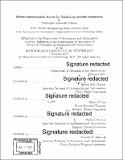Electro-aerodynamic thrust for fixed-wing aircraft propulsion
Author(s)
Gilmore, Christopher K. (Christopher Kenneth)
DownloadFull printable version (27.20Mb)
Other Contributors
Massachusetts Institute of Technology. Department of Aeronautics and Astronautics.
Advisor
Steven R.H. Barrett.
Terms of use
Metadata
Show full item recordAbstract
Aviation operations negatively impact global climate, degrade surface air quality, and create noise. Towards mitigating these effects, this thesis considers electro-aerodynamic (EAD) propulsion, a form of in-atmosphere electrostatic propulsion, which requires no on-board propellant and has zero primary gaseous emissions. In addition, thrust generation has the potential to be nearly silent and requires no moving parts. Despite these advantages, however, EAD propulsion has yet to be implemented in fixed-wing aircraft, in part due to the limited understanding of EAD thruster performance. The objective of this thesis is to determine the feasibility and viability of EAD propulsion in fixed-wing aircraft applications. This thesis begins with a theoretical assessment of EAD thruster performance. This includes quantification of fundamental thrust density limits and the effect of interacting electric fields on thrust-to-power performance due to closely spaced electrode pairs. Additionally, performance as a function of altitude and vehicle flight speed is quantified, where thrust-to-power ratio is estimated to decrease as both increase. Next, this thesis experimentally assesses the achievable thrust density of EAD propulsion. Current and thrust generated from arrays of electrode pairs are observed to be a function of non-dimensional pair spacings for both parallel and staged operation. A thrust per unit area of 2 - 3 N/m² and per unit volume of 5 - 15 N/m³ are estimated, achieving approximately 50 and 10% of the corresponding one-dimensional space-charge limits, respectively. Results suggest that EAD propulsion is most readily viable at the small unmanned aerial vehicle (UAV) scale. Finally, based on the conclusions of the thrust density assessment, this thesis presents the development of a first-of-its-kind EAD-propelled, small-UAV prototype with the goal of achieving steady-level flight. A design space analysis is performed, determining that designs capable of steady-level flight potentially exist. The prototype development effort concludes with at-scale performance quantification of the primary EAD UAV subsystems. Results indicate that the achievable weight-to-thrust ratio is comparable to the vehicle lift-to-drag ratio. This thesis concludes that at the selected scale of the UAV prototype, EAD propulsion is potentially viable, and steady-level flight is, at worst, "nearly" feasible with the current design.
Description
Thesis: Ph. D., Massachusetts Institute of Technology, Department of Aeronautics and Astronautics, 2017. Cataloged from PDF version of thesis. Includes bibliographical references (pages 301-314).
Date issued
2017Department
Massachusetts Institute of Technology. Department of Aeronautics and AstronauticsPublisher
Massachusetts Institute of Technology
Keywords
Aeronautics and Astronautics.